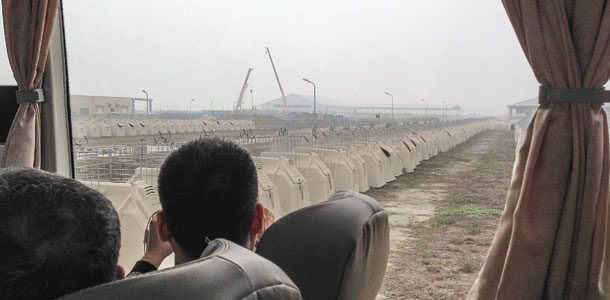When telling others I recently went to China, I usually get the question, “What’s it like over there?” Most people want to know how Chinese culture or customs are different or what the food is like. While I experienced plenty of those things, I specifically went to learn what the up-and-coming dairy industry there was like.
For years, I’ve read the articles describing China’s economy as “white-hot” and its government as “pro-dairy.” I wanted to see first-hand how China was trying to meet its huge gap between milk demand and supply.
Like most dairy industries around the world, an article written from a continent away isn’t as accurate as real life on the ground. Here were a few of my observations after experiencing the Chinese dairy industry first-hand:
Modernize, and do it quickly
I was with one of the first foreign groups to tour Nestle’s Dairy Farming Institute in Harbin, China, or the “Ice City” as it is nicknamed. Our guide was Robert Erhard, who is also the institute’s general manager.
His quote about the rapidly evolving Chinese dairy industry was the best summary of what is going on in China I heard on the trip. He said: “Europe took more than 100 years to modernize its dairy industry. The U.S. took 80 years to do it. Mexico did it in 50 years. China is trying to do it in 10 to 15 years. So, of course, they are going to have some challenges.”
In the next decade, 300 to 400 million Chinese will move from rural areas into awaiting high-rise apartments. (Many of these concrete giants are already built and sitting vacant.) That’s the equivalent of the entire U.S. population moving from the farm into a city. It’s an important prediction because milk consumption increases significantly among city dwellers.
According to Erhard, in-home milk consumption among urbanites (15.5 kg) is nearly 350 percent greater than that of rural residents (3.5 kg). When you factor in away-from-home consumption, urbanites consume 33 kg on average.
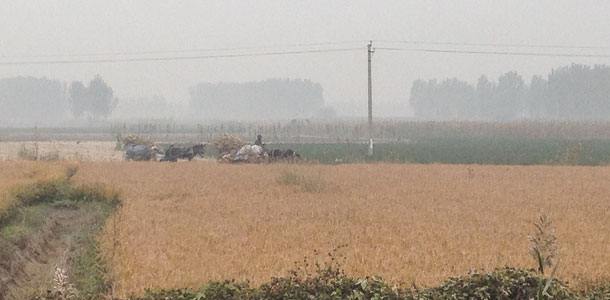
By 2024, that means that China will need new milk production (or imported dairy powder) that would equal the annual milk produced in both Australia and New Zealand in order to meet predicted demand.
For some perspective, compare these predictions to average annual consumption in the U.S. (100 kg) and you can see how even for a modernizing society, there is still a lot of dairy industry growth that could occur in China.
China wants and needs its own supply of milk to meet this demand. That’s the story I’d heard before I arrived in China. The scale of that demand gap I hadn’t perhaps understood before. The most surprising things I learned were the milk production challenges in-country producers face.
Figure out forages
A modern dairy cow requires high-quality forages to be most efficient at producing milk. Right now those forages, specifically alfalfa, either don’t exist in-country or can’t be produced at high enough quality.
The modern freestall facilities we toured reported they pay about $450 per U.S. ton to import high-quality alfalfa hay. The managers of these facilities say there is no alternative feedstuff available to replace the efficiency of this forage in their rations.
Chinese milk prices in 2014 ranged from $31 to $34 per hundredweight (cwt). Part of the reason why Chinese milk prices are so high is to account for the cost of this imported forage. Of all the farms I visited, no one seemed to like the cost of the imported hay but knew there was no other alternative.
China may one day figure out how to grow alfalfa in one of its many agricultural climate zones, but right now it’s mostly perceived that it can’t be done. The Chinese know they can build modern dairies to house top-end genetics they buy and import, but each one of those cows wants a mouthful of alfalfa, and it’s pricey to procure.
Also, the Chinese may have to reconsider their use of GMO crops. Like other Asian nations, the Chinese have been reluctant to embrace genetic engineering to improve efficiency of production. Use of these crops over time could increase the quantity of high-quality forage available.
Corn silage production and quality is a bit more of a bright spot. From visiting China, I can tell that the Chinese know how to grow corn and dry it. There were thousands of ears of the stuff lying out to dry on sideways, roads and other paved surfaces.
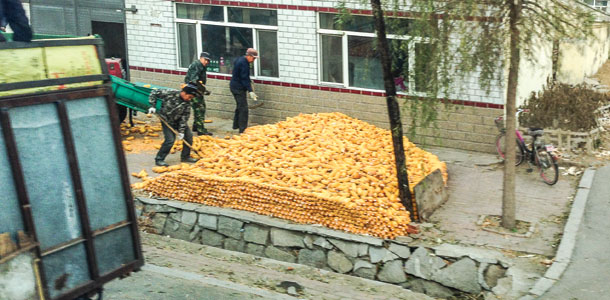
Getting the right mix of dry matter and moisture is their challenge. One dairy manager during our visit said it took 1,777 4-ton custom trucks, each hauling a load from one of the many local farms, to bring the dairy its silage over an 18-day period. The manager said that at one time there was a line of trucks at least a mile long waiting several hours to enter the dairy and drop their loads.
That’s one of the dichotomies I observed about China’s modernization process. Some parts of the system are very advanced (feeding the cows) while others are still very much behind (hauling feed with more than a thousand trucks).
Control those diseases
As any dairy manager who has expanded with purchased animals knows, growing a herd with someone else’s replacements is less than ideal. You get what you get, and it can take a while to clean up clinical diseases, not to mention subclinicals.
Almost every new, modern dairy I saw in China was stocked with animals sourced from outside the country. Most arrive as pregnant heifers and must be held in quarantine for weeks after arriving. Dairy managers say they lose body condition and don’t get a great start to their first lactation as a result of that mandatory time-out.
The Nestle farm that I visited had a strict biosecurity protocol complete with a shower-in, shower-out policy for employees. Our group dawned disposable coveralls and booties for our visit. It seemed the reason for all the safeguards was to keep out some of the herd health challenges that already exist in China on other farms.
Don’t spread it
Chinese dairy farmers are not permitted to land-apply their manure solids or effluent without off-farm processing it. For the foreign-investment dairies that we visited, that meant hauling liquid manure to be treated at a human wastewater treatment plan. One manager said this cost the dairy $30,000 to $40,000 a day.
Erhard said Nestle got an exemption to this rule from the Chinese government and aims to prove the sustainability and usefulness of manure solids and nutrients in crop production. But for now, manure effluent treatment is a huge cost to dairy operators.
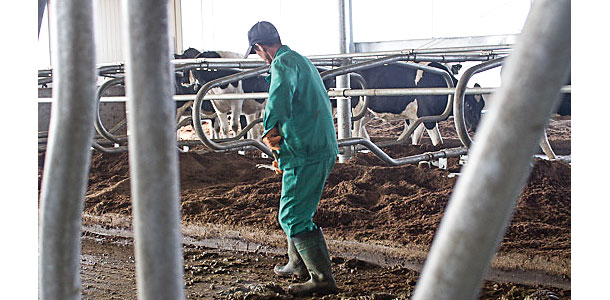
Food security issues, in general
On a shuttle ride down the mountain from visiting the Great Wall of China, I sat behind a lady who lived in North America for 13 years. She spoke very good English and had moved back to China to take care of her elderly parents. She was intrigued by the purpose of our visit.
When someone said we were dairy producers and industry representatives, she without prompting referenced China’s 2008 melamine scandal. “You have to limit how much milk you give children in China,” she said. Obviously, the Chinese are still dubious about the safety of their milk supply.
During a visit to a Nestle factory, I asked the plant manager if he thought powdered infant formula would ever be produced with Chinese-sourced milk. He shook his head in disagreement.
During my visit, I learned that it’s not just the dairy industry in China to have experienced confidence-shaking scandals. There have been other agricultural sectors to have similar damaging revelations about food quality and security. It’s not something the Chinese are proud of. Their Supreme Court has even gone so far as to encourage the death penalty for executives who are ensnared in future scandals.
Post-melamine scandal, the government has cracked down on pickup from “backyard dairies” or farms with fewer than 10 cows. As a result, our guide at the Nestle Innovation Center said it doesn’t make sense to have fewer than 20 cows in China now. Within just a few more years that economic breakeven point might require 80, or maybe even 100 cows. The average dairy size in China now is about 100 cows.
There are presently no co-ops in China. All dairies sell directly to a processor, such as Nestle. One farm manager longed for a system more like the U.S. He said: “We are butchered by processors because they dictate the price.” He hoped that a farmer co-op might emerge in the next five to 10 years.
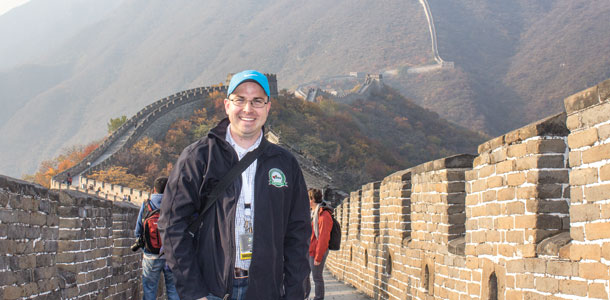
More professional managers needed
Dairy owner Charles Shao, who was born in Taiwan, made a fortune in Silicon Valley and eventually moved back to mainland China to invest in dairies 10 years ago, said one of the industry’s biggest challenges is a lack of professional management.
It’s true that on the foreign-investment dairies I visited, the managers were U.S.-born and contracted to work in China for two to three years. One of these managers said he promised investors he would have the dairy ready for a Chinese national to run it by the end of his contract.
That’s where Nestle’s new institute comes into the picture. Erhard said that in China, dairy farmers are perceived as peasants. “Our vision is to change that into them being perceived as leaders,” he said.
At the new institute, Chinese farmers will be able to graduate through several levels of instruction, including courses for workers, specialists and managers. The teaching methods include a mix of lectures, case studies, lab work, computer exercises and hands-on application.
Students earn certificates upon completion of coursework. Erhard was careful to explain that Nestle’s approach was to provide an educational platform to support the industry while it discovers its own identity.
“The Chinese have decided they don’t want a U.S. dairy system. They don’t want a European dairy system. Or a Swiss grazing system. They want a Chinese dairy system,” Erhard said.
Over the course of a week in China, I observed an exciting and promising dairy industry. The dairy operators there are no less excited and passionate than any of the other producers I’ve met in modern dairy industries throughout the world. As one farm manager put it, “Entrepreneurial dairy farms in China just need to grow, and grow fast.”
The Chinese may need a little more time than they think it will take to modernize their country’s milk production, but I don’t doubt they can do it. They certainly want it enough. And I wouldn’t bet against them becoming the fastest country in modern history to get there. PD
PHOTOS
PHOTOS 1 and 2: The disparity in modernization of China’s dairy industry was best captured in these two photos. From one side of our tour bus we could see mules pulling carts loaded with corn stalks at harvest time. On the other side of the street was this photo of calf hutches from a foreign-investment dairy.
PHOTO 3: Corn after harvest is often dried on any paved public surface in China, including sidewalks, rarely-used streets and even highways. A majority of methods for harvesting or processing corn in China are not mechanized.
PHOTO 4: Professional dairy management is one of the challenges to Chinese dairy industry growth, according to current Chinese dairy owners.
PHOTO 5: Progressive Dairyman Editor Walt Cooley visited China in October with Artex Barn Solutions and an international group of dairy producers. Photos by Walt Cooley.

Walt Cooley
Editor
Progressive Dairyman
